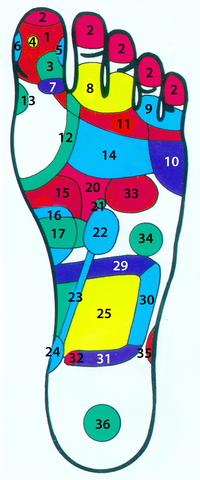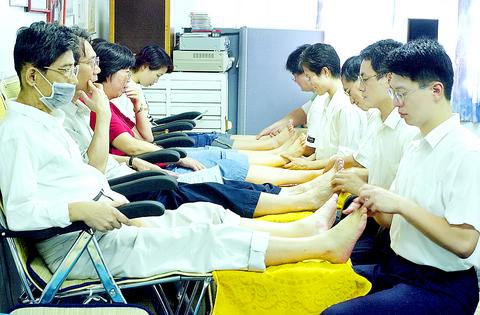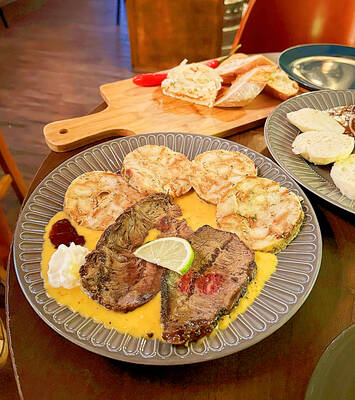Inside the long storefront windows lie a row of big comfortable couches on which a dozen customer are reclined. In front of them, massage therapists are concentrating on their customers' feet. Using only their hands, a wooden massage bat and some cream, they swiftly press, push and rub. Some of their Japanese customers give out groans of pain -- "Itai! Itai! Itai!" -- but most customers, foreign or local, seem to enjoy it. Three young Japanese women take pictures of each other while being massaged, their fingers stretched in a "V" gesture while their faces remain pinched in pain.
"Taiwanese foot massage is very famous in Japan. I heard it's more painful than in Thailand and other countries. I like it," said 24 year-old Yasuko Shishido.

Shishido was in Taipei for just a day and kept busy tasting local dumplings, sampling Oolung tea and pineapple cakes and was eager to get in a foot massage before having to leave Taiwan.

PHOTO: CHEN CHENG-CHANG, TAIPEI TIMES
"I come to Taiwan for business twice a year and always come here, however busy my trip," said 60-year-old Tuneo Iwane, another Japanese customer at this foot massage parlor.
For many Japanese tourists, Taiwan's attractions aren't only the Palace Museum and Chiang Kai-shek Memorial Hall, but the masochistic pleasure of foot massage.

PHOTO: CHEN CHENG-CHANG, TAIPEI TIMES
Walking along Taipei's Minchuan East Road or Linsen North Road, there can be seen more than a dozen foot massage parlors, each with a huge, eye-catching sign of a colorfully diagrammed foot. Many of them bear the name Father Wu Foot Massage.
Father Josef Eugster from Switzerland, who goes by the Chinese name Wu Ro-shih (吳若石), said the parlors and their popularity are something he would never have thought of 23 years ago, when foot massage was a simple self-help therapy. It was more than two decades ago when he "re-discovered" and began promoting the practice that can be found in the ancient histories of China and Egypt, a therapy known as foot reflexology.
A month ago he held a press conference clarifying to the public for the first time that he had never authorized anyone to use his name as a trademark, nor is the colorful foot diagram of his making. The phenomenal success of foot reflexology in Taiwan makes Eugster proud, but at the same time worried.
After arriving in Taiwan 30 years ago to preach in Taitung, Eugster became bothered by arthritis. Another Swiss priest gave him a book about foot reflexology titled Good Health for the Future (1976), by Heidi Masafret. He studied the book and experimented on himself. Pleased with the results, he began practicing on his disciples to help them with their own health problems, but also as a way to spread the gospel.
According to theories expounded on by Eugster and Eugene Cheng (
Reflexology theory divides the foot into 26 bones and five major reflex areas. To massage the foot is to stimulate the problematic organs or "push away the pathological sediments," Eugster said.
Cheng also combines reflexology theory with Chinese medicine's five-elements concept in practicing foot massage. For example, if one feels pain or sediment when pressing on one part of the left sole (see diagram, area 33), it is an indication of a heart problem. According to the five-elements theory, the heart belongs to the fire element, so in addition to the heart, the reflex areas of the intestine and liver must also be massaged in order to maintain a healthful balance.
After considerable local and international media coverage 20 years ago, Eugster gained fame and a flock of foot-massage followers. Shuttling from workshops to hospitals and speaking engagements, the fruit of Eugster's work can be seen in nearly every city in Taiwan, with around 1,000 foot massage parlors on the island, according to Cheng. And it's become more popular, losing its focus on therapy and becoming more of a superficial consumer fad.
It's also become a huge money-making enterprise lacking in regulation. Some parlors have developed into multi-function health centers. In addition to offering foot massage, one parlor called Tsai Chun Kuan (
Tsai Chun Kuan has also contracted with several travel agencies to bus tourists directly to the parlor. Tourists pay NT$700 for a half-hour foot massage, NT$200 of which goes to the travel agents. For Japanese, it's still a reasonable price compared with what they would pay in Japan.
Currently in Taiwan, the price for a foot massage is between NT$500 and NT$700 for 30 minutes. There is no regulation of price or quality, which can vary widely.
Lu Wan-ping (
Since 1984, the Cabinet-level Department of Health (
The ROC Foot Reflexology Association, founded by Cheng and Eugster, is the only group in Taiwan that certifies massage therapists in their chosen trade. But there remains a void of institutionalization on the correct practice and technique of foot reflexology, according to Cheng.
"If they want to use my name, they have to employ my standard of skill and quality of practice," Eugster said. "I'll have to train them myself."

Seven hundred job applications. One interview. Marco Mascaro arrived in Taiwan last year with a PhD in engineering physics and years of experience at a European research center. He thought his Gold Card would guarantee him a foothold in Taiwan’s job market. “It’s marketed as if Taiwan really needs you,” the 33-year-old Italian says. “The reality is that companies here don’t really need us.” The Employment Gold Card was designed to fix Taiwan’s labor shortage by offering foreign professionals a combined resident visa and open work permit valid for three years. But for many, like Mascaro, the welcome mat ends at the door. A

Divadlo feels like your warm neighborhood slice of home — even if you’ve only ever spent a few days in Prague, like myself. A projector is screening retro animations by Czech director Karel Zeman, the shelves are lined with books and vinyl, and the owner will sit with you to share stories over a glass of pear brandy. The food is also fantastic, not just a new cultural experience but filled with nostalgia, recipes from home and laden with soul-warming carbs, perfect as the weather turns chilly. A Prague native, Kaio Picha has been in Taipei for 13 years and

The Western media once again enthusiastically forwarded Beijing’s talking points on Japanese Prime Minister Sanae Takaichi’s comment two weeks ago that an attack by the People’s Republic of China (PRC) on Taiwan was an existential threat to Japan and would trigger Japanese military intervention in defense of Taiwan. The predictable reach for clickbait meant that a string of teachable moments was lost, “like tears in the rain.” Again. The Economist led the way, assigning the blame to the victim. “Takaichi Sanae was bound to rile China sooner rather than later,” the magazine asserted. It then explained: “Japan’s new prime minister is

Since Cheng Li-wun (鄭麗文) was elected Chinese Nationalist Party (KMT) chair on Oct. 18, she has become a polarizing figure. Her supporters see her as a firebrand critic of the ruling Democratic Progressive Party (DPP), while others, including some in her own party, have charged that she is Chinese President Xi Jinping’s (習近平) preferred candidate and that her election was possibly supported by the Chinese Communist Party’s (CPP) unit for political warfare and international influence, the “united front.” Indeed, Xi quickly congratulated Cheng upon her election. The 55-year-old former lawmaker and ex-talk show host, who was sworn in on Nov.